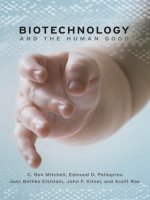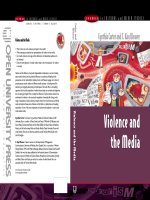georgetown university press biotechnology and the human good may 2007
Bạn đang xem bản rút gọn của tài liệu. Xem và tải ngay bản đầy đủ của tài liệu tại đây (859.63 KB, 225 trang )
BIOTECHNOLOGY
HUMAN GOOD
AND
THE
PAGE i
16334$ $$FM 03-23-07 13:33:31 PS
BIOTECHNOLOGY
HUMAN GOOD
C. Ben Mitchell, Edmund D. Pellegrino,
Jean Bethke Elshtain, John F. Kilner,
and Scott B. Rae
AND
THE
Georgetown University Press / Washington, D.C.
PAGE iii
16334$ $$FM 03-23-07 13:33:32 PS
As of January 1, 2007, 13-digit ISBN numbers have replaced the 10-digit
system.
13-digit 10-digit
Paperback: 978-1-58901-138-0 Paperback: 1-58901-138-4
Georgetown University Press, Washington, D.C. www.press.georgetown.edu
᭧2007 by Georgetown University Press. All rights reserved. No part of this
book may be reproduced or utilized in any form or by any means, electronic or
mechanical, including photocopying and recording, or by any information
storage and retrieval system, without permission in writing from the publisher.
Biotechnology and the human good / C. Ben Mitchell . . . [et al.].
p. ; cm.
Includes bibliographical references and index.
ISBN 1-58901-138-4 (alk. paper)
1. Biotechnology—Moral and ethical aspects. 2. Medical ethics.
3. Values. I. Mitchell, C. Ben.
[DNLM: 1. Biotechnology—ethics. 2. Christianity. 3. Genetic
Engineering—ethics. TP 248.23 B615 2006]
TP248.23.B566 2006
174Ј.96606—dc22 2006021475
⅜ϱ This book is printed on acid-free paper meeting the requirements
of the American National Standard for Permanence in Paper for
Printed Library Materials.
14 13 12 11 10 09 08 07 9 8 7 6 5 4 3 2
First printing
Printed in the United States of America
PAGE iv
16334$ $$FM 03-23-07 13:33:32 PS
Contents
Preface
vii
Acknowledgments
xiii
ONE
The Rapidly Changing World of Biotechnology
1
TWO
Humanity and the Technological Narrative
15
THREE
Biotechnology and Competing Worldviews
32
FOUR
Biotechnology and Human Dignity
58
FIVE
Biotechnology and the Quest for Control
87
PAGE v
16334$ CNTS 03-23-07 13:33:39 PS
vi Contents
SIX
Biotechnology, Human Enhancement, and the Ends of
Medicine
110
SEVEN
Conclusion: Toward a Foundation for Biotechnology
137
Notes
159
Authors and Collaborators
193
Index
197
PAGE vi
16334$ CNTS 03-23-07 13:33:39 PS
Preface
LISTENING to Kevin Warwick, a professor of cybernetics at the
University of Reading in England, enthuse about his research is like
listening to a prepubescent schoolboy describing his trip to Disney
World. Warwick claims to be the world’s first cyborg: part human, part
machine. On Monday, August 24, 1998, he had a silicon chip tran-
sponder surgically implanted in his forearm. Once fitted with this new
implant, he returned to his laboratory, where the doors opened auto-
matically, lights turned on as he walked into rooms, and his computer
greeted him every morning. As thrilling as this was, it was only the
beginning.
In March 2002, Warwick embarked on Project Cyborg 2.0. This
time, surgeons at Oxford’s Radcliffe Infirmary implanted a 100-micro-
electrode array directly into the median nerve fibers of his left arm. This
new device allowed the professor’s nervous system, including his brain,
to be connected directly to a computer. As a result, Warwick was able
to control a robotic arm in his lab, drive an electric wheelchair with
minimal hand movement, and, through a secret Internet connection,
control an articulated robotic arm on another continent. He was both
able to send signals across the ocean and receive them directly into his
nervous system.
Warwick’s wife, Irena, volunteered to have a similar implant placed
in her wrist, allowing husband and wife to ‘‘communicate’’ directly
through the computer, thereby becoming the world’s first cyborg
couple.
PAGE vii
16334$ PREF 03-23-07 13:33:44 PS
viii Preface
Warwick’s excitement about his experiments is almost overwhelm-
ing, and for good reason. This new technology may one day be used
to treat many types of neuromuscular disorders. A robotic prosthesis
may restore arms, legs, or other appendages lost through injury. Even-
tually, says Warwick, the technology may allow us to communicate our
emotional states directly to another person. But the same technology
may also be used to create armies of efficient cyborg killers. With the
computational power of a laptop computer and a rather basic knowl-
edge of microbiology, one can now manipulate living organisms in
one’s own basement lab, creating who knows what? Technology, in-
cluding biotechnology, may be used for evil ends as easily as for good
purposes, and this worries Warwick. But what is one to do? Technol-
ogy marches on.
If we understand technology to include any work-producing exten-
sion of the body of an individual, then the first person to use a stick to
make a hole in which to plant a seed was a technologist. In fact, tool
making was one of the first human technological advances. Human be-
ings are by nature technologists. Therefore, biotechnology is a funda-
mentally human endeavor.
Nevertheless, when the media announce a new biotechnological
development—such as the possibility of human cloning or the creation
of animal–human hybrids—there is a collective gasp. How do we ac-
count for what some might describe as our schizophrenic reactions to
biotechnology? How do we test our intuitions about emerging
biotechnologies?
The University of Montana philosopher of technology Albert Borg-
mann has wryly observed that reactions to emerging biotechnologies,
including cybernetics and artificial intelligence, ‘‘are as divided as they
are to carnival rides—they produce exhilaration in some people and ver-
tigo in others’’ (‘‘On the Blessings of Calamity and the Burdens of
Good Fortune,’’ Hedgehog Review 4 [Fall 2002]: 7–24).
Techno-exhilaration and techno-vertigo are intuitional responses to
these new technologies. Some technologies call on our adrenal glands
to work overtime because of the breathtaking nature of new power
within our grasp. From biplanes, to space flight, to moon walks, the
human heart races with anticipation at the next great achievement.
PAGE viii
16334$ PREF 03-23-07 13:33:44 PS
Preface ix
From blood transfusions, to the discovery of DNA, to gene therapy,
the passion for knowledge pushes us into new frontiers. At the same
time, it seems, every power of mastery over nature also brings with it
greater power for mastery over other human beings, and every inch
closer to technological utopia seems to be another step toward techno-
logical oblivion.
This book is the effort of a multidisciplinary group of physicians, scien-
tists, philosophers, ethicists, theologians, and a lawyer to grapple with
these questions and to offer a way of thinking about technology—
especially biotechnology—that we hope will make sense of some of our
intuitions. However, a warning is in order. History has shown that
some of our intuitions about biotechnology are wrong and should be
questioned. For instance, in the seventeenth century, blood transfu-
sions were outlawed in France and England. Now more than 39 million
units of blood and blood products are transfused every year in the
United States alone. The intuition that it was wrong to transfer blood—
the elixir of life, as it is sometimes called—has been revised over time.
(For an intriguing account of this history, see Pete Moore, Blood and
Justice: The 17th Century Parisian Doctor Who Made Blood Transfusion
History [San Francisco: Jossey-Bass, 2002].) So part of the purpose of
this book will be to test our intuitions about biotechnology.
Chapter 1 surveys the rapidly expanding arena of human biotechnol-
ogy. Technologies such as genetic manipulation, cybernetics, robotics,
and nanotechnology not only offer great hope for therapeutic interven-
tions but also portend potentially devastating challenges to our under-
standing of what it means to be human and, in some instances, to our
humanity itself. Genetic enhancements, some argue, may lead human
beings to a technologically achieved immortality. But at what cost to
our humanity?
Chapter 2 critiques several narrative philosophies that offer argu-
ments for or against technological expansion. Though by no means the
only narrative, what the American studies professor David E. Nye calls
the ‘‘second-creation narrative’’ seems to be a dominant theme of the
Western story of technological achievement. Without modification, this
narrative seems to be an insufficient ground for our biotechnological
PAGE ix
16334$ PREF 03-23-07 13:33:44 PS
x Preface
agenda. A narrative of morally responsible stewardship, however, offers
both an impetus for biotechnology and realism about the potential for
misuses of biotechnology. In our view, biotechnology is a qualified
good and should be pursued with vigor, but not without caution. We
are not determinists when it comes to biotechnology. We do not believe
that because we can do something we ought to do it; or that once we
can do something, it is inevitable that we will do it. On the contrary,
as stewards, we believe biotechnology should be used to relieve human
suffering and to protect human dignity, without relieving humans of
their very humanity.
Chapter 3 explores several competing worldviews that inform our
attitudes toward biotechnology. Philosophical naturalism has almost
imperialistic status in the sciences in general and in biotechnology in
particular. We argue that philosophical naturalism is limited and reduc-
tionist. Alternatively, though environmentalist biocentrism, or deep
ecology, is more protective of living organisms, the movement leads to
undervaluing the human species vis-a
`
-vis other species. We maintain
that Judeo-Christian theism offers a more satisfying way to frame the
goals of biotechnology because it offers a view of human dignity, com-
bined with a purposive history, that warrants therapeutic applications
of biotechnology without either sanctioning the wholesale modification
of the human species or overprotecting the environment to the detri-
ment of the human species.
In chapter 4, we elucidate a view of human dignity that ought to
underwrite the biotechnological enterprise. The notion of human dig-
nity emerges from a lengthy, and sometimes painful, history in the West
and has significantly shaped our understanding of human rights, includ-
ing the protection of human subjects in research. Assaults against
human dignity have led to some of the darkest days in history, including
American chattel slavery, the Holocaust in Nazi Germany, and viola-
tions of human rights in scientific experimentation. Only a robust un-
derstanding and protection of human dignity can prevent us from
repeating the horrors of the past. When properly understood, human
dignity is—or can become—a shared value for informing law and
policy.
PAGE x
16334$ PREF 03-23-07 13:33:45 PS
Preface xi
Does the idea of human dignity entail complete control over one’s
future destiny, including, if one freely chooses, altering or even jettison-
ing one’s body? Chapter 5 examines the contemporary penchant for
autonomous control that seems to be driving many of those who are
uncritical proponents of biotechnology. A renewed appreciation for
human embodiment and community would resist the neo-Gnostic
tendencies of twenty-first century biotechnology.
Chapter 6 provides a historical and conceptual framework for think-
ing about the nature of morally responsible stewardship in relation to
the goals of medicine. Are enhancement technologies consistent with
the teleology of medicine? We argue that they are not. Moreover, we
maintain that some biotechnologies fatally compromise the physician–
patient relationship, turning patients into consumers and physicians
into mere contractors. Medicine ought to resist being co-opted by a
narcissistic, consumerist culture.
In chapter 7, we offer a series of profound questions that must be
answered if technology is to serve human needs and goals. In the last
section of the chapter, we bring a philosophical and theological frame-
work to bear on biotechnology. We believe that it is not only appro-
priate but also necessary to question biotechnology—not to stop it, but
to keep it honest. We also believe that by asking the hard questions
about biotechnology, we can move together toward a truly human fu-
ture in which therapy, healing, and health can be preserved without
forfeiting medicine to the whims of a dysfunctional utopianism.
PAGE xi
16334$ PREF 03-23-07 13:33:45 PS
Acknowledgments
READERS will notice that we do not identify an author for each
chapter of this book. This directly reflects our methodology. After the
book’s authors and external reviewers were chosen, the team met for a
two-day retreat. Each of us presented our initial thoughts about the
goals and content of the project. After extensive critiques, we agreed
on a trajectory for the book. Next, each author presented a draft manu-
script on one of the topics for the book. The drafts were reviewed by
each author; by the project director, C. Christopher Hook, M.D.; and
by several external reviewers, including Paige Comstock Cunningham,
J.D., and Gilbert C. Meilaender, Ph.D. In addition, two reviewers out-
side North America commented on the essays—from Australia, Graham
Cole, Ph.D., and from Ireland, Stephen Williams, Ph.D.—providing
welcome and helpful international perspectives.
Additional feedback was received when second drafts of the material
were presented to a larger audience during the ‘‘Remaking Humanity?’’
conference sponsored by the Center for Bioethics and Human Dignity
in Bannockburn, Illinois. The ongoing conversation and collaboration
continued as the team met twice to review the external feedback and
self-critiques. The final review was completed early in 2006. We would
especially like to thank the outside commentators for helping us focus
our thinking. Without their extraordinarily helpful comments, the book
would not have come together as it has.
In sum, this book is the product of substantial longitudinal collabo-
ration and conversation, with each person making significant contribu-
tions to each chapter of the whole.
PAGE xiii
16334$ $ACK 03-23-07 13:33:52 PS
xiv Acknowledgments
We are very grateful for the financial support this project has received
from the William H. Donner Foundation, New York, and from
Fieldstead & Company, Irvine, California, and for administrative sup-
port from the Center for Bioethics and Human Dignity.
Our deepest thanks go to the project editor, Louise Kaegi, M.A.,
who gave the book one voice. Louise writes on health care, ethics, edu-
cation, and cultural politics, was formerly executive editor of the Joint
Commission on Accreditation of Healthcare Organizations’ Joint Com-
mission Benchmark newsletter, and has written articles on health care
for other newsletters, such as Minority Nurse. We would also like to
thank Michael Sleasman, a doctoral candidate and friend at Trinity
Evangelical Divinity School, in Deerfield, Illinois, for his bibliographic
assistance with a part of the project.
This book belongs largely in the genre of bioethics. Bioethics may
be the most salient contemporary example of interdisciplinary research.
If there were ever a time when one scholar, working solely in her office,
could become an expert on all the topics under her discipline, that day
has passed. With the explosive development of biotechnology, the bur-
geoning growth of specialties and subspecialties, and the large output
of literature, collaborative research will be increasingly necessary. We
applaud Chris Hook’s vision for the type of deep collaboration repre-
sented in this volume. Likewise, we are grateful to Georgetown Univer-
sity Press and its director, Richard Brown, for recognizing the
importance of this work. We hope that other presses will understand
how important collaborative research is in this area and will support
colleagues in their joint labors in bioethics.
PAGE xiv
16334$ $ACK 03-23-07 13:33:52 PS
CHAPTER ONE
The Rapidly Changing World
of Biotechnology
We reduce things to mere Nature in order that we may ‘‘conquer’’ them.
We are always conquering Nature, because ‘‘Nature’’ is the name for what
we have, to some extent, conquered. The price of conquest is to treat a
thing as mere Nature. . . . As long as this process stops short of the final
stage, we may well hold that the gain outweighs the loss. But as soon as
we take the final step of reducing our own species to the level of mere
Nature, the whole process is stultified, for this time the being who stood
to gain and the being who has been sacrificed are one and the same.
—C. S. Lewis, The Abolition of Man
TECHNOLOGY is an integral part of human life, from the simplest
tools made from plants and stones to our digital computers, cardiac
pacemakers, pharmaceuticals, and the ubiquitous media of communica-
tion and transportation. Human beings are toolmakers; we are Homo
faber. Although other animals demonstrate the ability to use elements
of their environments as simple tools, such as otters using stones to
open the shells of mollusks, humankind is marked by its whole-scale
commitment to develop and use new tools. It is hard for human beings
to even image a world without the use of tools of some kind. Further, it
is doubtful that as a species Homo sapiens would survive without tools,
without technology.
Biotechnology is a set of technologies specifically aimed at manipu-
lating living things, including human beings themselves, arguably
for the common good. Some of the most amazing tools of the past
fifty years have appeared in the sphere of medical biotechnology—
PAGE 1
16334$ $CH1 03-23-07 13:34:25 PS
2 CHAPTER ONE
antibiotics, psychopharmaceuticals and other drugs, and recombinant
technologies that produce hormones or clotting factors (e.g., insulin,
erythropoeitin, or Factor VIII for hemophiliacs), gene manipulation
that produces disease or pest resistance in crops, and engineered drugs
to treat cancer (e.g., imatinib mesylate, or Gleevec, for chronic myelog-
enous leukemia, or rituximab for the treatment of lymphoma and an
increasing number of autoimmune diseases). For the purposes of our
discussion, biotechnology also includes tools that directly interact with
the systems of the body for the purposes of diagnosis, health restora-
tion, and disability amelioration. This category of biotechnologies in-
cludes organ and blood cell transplantation, pacemakers, new forms of
orthopedic appliances, genetic testing and the first forays into gene
therapy, neural implants to treat Parkinson’s disease or depression, and
a whole host of tools and treatments now common in medical practice.
Many of these advances have been welcomed enthusiastically,
whereas others have been greeted with skepticism or open hostility
(e.g., genetically modified food). Increasingly, discussions about the
means of biotechnology have joined controversies about its ends. Wit-
ness the heated debate about embryonic stem cell research, or about
human cloning with a goal of developing new treatments for serious
diseases like Parkinson’s disease, juvenile diabetes, and a host of others.
Increasingly, biotechnologies are being created and used not for
therapeutic ends but for the purpose of ‘‘enhancing’’ mental or athletic
function or altering physical appearance.
1
Breast implants and other
cosmetic surgery, anabolic steroids and erythropoeitin, botulinum
toxin (Botox), methylphenydate (Ritalin), and SSRI (selective seroto-
nin reuptake inhibitors) antidepressants (e.g., Paxil, Prozac, and Cel-
exa) are being used not for the purpose of healing or restoring but in
the hope of making us ‘‘better than well.’’
2
In 2004, just under $12.5
billion was spent in the United States on cosmetic procedures (surgery
and nonsurgical such as Botox injections), a value far greater than ten
times that committed to research for a cure or more effective treatments
for malaria, still one of the world’s major killers.
3
New agents that are
being developed to treat memory impairment in dementing diseases
such as Alzheimer’s disease are expected to have a huge market among
PAGE 2
16334$ $CH1 03-23-07 13:34:25 PS
The Rapidly Changing World of Biotechnology 3
those who simply want to improve their memory for socially competi-
tive reasons.
4
Revisiting Eugenics
One of the most remarkable biotechnology projects of the past fifteen
years has been the discovery of the human genetic code, in the Human
Genome Project (HGP). Yet much has been written about the potential
sources of harm and benefit in this new knowledge about the code of
life. Will we have to again endure the abuses of the past performed in
the name of some eugenic ideal? We are already engaging in both posi-
tive and negative eugenics through the use of prenatal and preimplanta-
tion genetic diagnosis. Some are more concerned that the eugenic
programs we face now and in the future will not so much be state sanc-
tioned (although there are governments around the world explicitly
promoting eugenic programs
5
) but rather will be coerced socially by a
‘‘eugenics of the marketplace.’’
6
Several authors have quite explicitly
stated not only that eugenics in some form is inevitable but also that
genetically reengineering the human species is desirable.
7
Thus one set
of questions before us as the community of humankind, and as individ-
uals, is: Should we deliberately reengineer human beings by genetic
manipulation? Should we use our genetic knowledge to determine what
kind of people will be allowed to exist?
Bypassing Genetics and Reproduction
Other technologies are being rapidly developed, however, that will en-
able human beings to reengineer themselves without the need to in-
volve genetic and reproductive mechanisms. Rather, the existing person
will soon be offered an array of means to remake himself or herself via
tissue reconstruction or prosthetic enhancement. These additional
means of human reengineering are cybernetics and nanotechnology.
Because many readers may be less familiar with these fields than with
the potential for genetic manipulation, we will present a brief overview
PAGE 3
16334$ $CH1 03-23-07 13:34:25 PS
4 CHAPTER ONE
of them and their potential for producing tools for reengineering
humankind.
8
Cybernetics
Cybernetics in its purest definition is the science of ‘‘control and com-
munication in the animal and the machine’’ and was devised as a field
by Norbert Weiner in the 1940s. The word is derived from the Greek
for steersman, kybernetes.InThe Human Use of Human Beings, Weiner
wrote that ‘‘society can only be understood through a study of the mes-
sages and the communication facilities which belong to it; and that in
the future development of these messages and communication facilities,
messages between man and machines, between machines and man, and
between machine and machine, are destined to play an ever-increasing
part.’’
9
In his Introduction to Cybernetics, W. Ross Ashby noted that this
theory of machines focuses not on what a thing is but on what it does:
‘‘Cybernetics deals with all forms of behavior insofar as they are regular,
or determinate, or reproducible. The materiality is irrelevant.’’
10
Recog-
nizing that there are significant similarities in biological and mechanical
systems, subsequent researchers have pursued the ideal of merging bio-
logical and mechanical/electrical systems into what Manfred Clynes
and Nathan S. Kline termed cyborgs or cybernetic organisms.
11
In this
sense, cybernetics has taken on the meaning of adding prostheses to the
human, or animal, body to replace lost function or to augment biologi-
cal activity.
Humans have long used tools to augment various functions, and for
centuries they have also intimately attached some of these tools to their
bodies. Filled or artificial teeth, glasses and contact lenses, hearing aids,
pacemakers, and/or artificial limbs are all examples of this phenome-
non. Recently, significant advances in the fields of neuroscience and
computer technology have made possible the direct interface of animal
or human nervous systems with electromechanical devices. A few exam-
ples in this evolving field are the creation of neural-silicon junctions
involving transistors and neurons to prepare neuronal circuits, the re-
mote control of mechanical manipulator arms by implants inserted into
PAGE 4
16334$ $CH1 03-23-07 13:34:26 PS
The Rapidly Changing World of Biotechnology 5
the motor cortex of owl monkeys, and remote controlling rats to move
over a directed path via implanted electrodes and a computer moder-
ated joystick.
12
Investigators at the Max Planck Institute for Biological Cybernetics
in Tu
¨
bingen, Germany, have successfully grown connections between
the neurons of several species of animals and transistors, allowing two-
way communication through the silicon-neuronal junction. Research-
ers at Infineon Technologies in Munich, working in collaboration with
the Max Planck group, announced the development of the ‘‘neuro-
chip.’’ This device has greater than 16,000 sensors per square millime-
ter and is able to record at least 2,000 readings per second (or in aggre-
gate, 32 million information values per second). Neurons are kept alive
in a special nutrient fluid that coats the chip’s surface. The architecture
of the chip ensures that each neuron in the matrix covers at least one
sensor. Thus without the need to invade the structure of the neurons
themselves, the chip can maintain prolonged undisturbed interactions
between neurons and measure and process the flow of information
through the neuronal network.
13
Significant strides have also been made in understanding and manip-
ulating the sense of vision. In 1999, Garrett B. Stanley and colleagues
at the University of California, Berkeley, were able to measure the neu-
ronal activity of the optical pathway of a cat via 177 electrical probes,
process the information, and recreate rough images of what the cat’s
eyes were viewing at the moment. Though the images were of fairly
poor resolution (similar to the degree of resolution of computed to-
mography [CT] scans in the early 1980s), it is only a matter of im-
proved signal processing to be able to produce more exact images.
14
The implication of this line of research is that if we can decode the
visual images from their neural representations, we will in time be
equally capable of directly transmitting ‘‘visual’’ images into a recipi-
ent’s brain, bypassing the use of, or need for, light-collecting visual
organs.
Although this sort of technology could become the ultimate tool for
virtual reality, the most important potential is for the restoration of
sight to the blind.
15
Researchers at the Dobelle Institute, with its Arti-
ficial Vision for the Blind program (formerly headquartered in Zurich,
PAGE 5
16334$ $CH1 03-23-07 13:34:26 PS
6 CHAPTER ONE
with a laboratory in New York City; since 2001, headquartered in Lis-
bon) have implanted electrodes connected to a digital camera/com-
puter complex into the visual cortex of blind patients, restoring some
degree of sight. In one case, the patient was even able to drive around
the parking lot of the hospital with some degree of restored vision.
16
Investigators at Emory University in Atlanta have helped two pa-
tients with locked-in syndrome, a state in which the brain is conscious
but cannot produce any movement of the patient’s voluntary, skeletal
muscles. The unfortunate patient is often thought to be in a persistent
vegetative state. The two received brain implants, into which their neu-
rons grew, establishing a link with a computer. This enabled the pa-
tients to use their minds to control a cursor on a computer screen and
thus communicate with others.
17
In June 2000, Chicago’s Optobionics Corporation implanted the
first artificial retinas made from silicon chips in the eyes of three blind
patients suffering from retinitis pigmentosa. Each implant was 2 milli-
meters in diameter and 1/1,000 of an inch thick and contained approx-
imately 3,500 microphotodiodes that converted light energy into
electrical impulses to stimulate the remaining functional nerve cells of
the retina.
18
A team at the University of Southern California in Los Angeles is
planning to replace part of the hippocampus of rats with a special silicon
chip. The hippocampus is a crucial part of the brain where the laying
down and retrieval of memories is coordinated. The implant would in
effect be a memory chip.
19
Though designed as a treatment to replace
damaged tissue in poststroke patients or patients with Alzheimer’s dis-
ease, it is not difficult to imagine such a device (which at the time of
this writing is estimated to be at least ten years off ) being used for
memory augmentation for the normal as well.
20
Though this is exciting
on one level, devices such as this illustrate the significant technical and
safety issues involved in developing and employing neuroprostheses.
Even if such a device could communicate with the rest of the brain in
storing memories, there are still serious issues to be resolved. Not only
does the hippocampus participate in memory, but it is also a significant
component of the brain pathways that affect awareness, consciousness,
PAGE 6
16334$ $CH1 03-23-07 13:34:27 PS
The Rapidly Changing World of Biotechnology 7
and emotions. Thus, how such a device may affect other significant ele-
ments of brain function and personality is unknown.
Medical Nanotechnology
Asthenameimplies,nanotechnology is engineering or manipulating
matter, and life, at nanometer scale—that is, one billionth of a meter.
Ten hydrogen atoms side by side span 1 nanometer. The deoxyribonu-
cleic acid (DNA) molecule is 2.3 nanometers in diameter. If such feats
were possible, then it is conceivable that the structures of our bodies
and our current tools could be significantly altered. In recent years,
many governments around the world, including the United States with
its National Nanotechnology Initiative, and scores of academic centers
and corporations have committed increasing support for developing na-
notechnology programs.
21
For example, in 2003 the U.S. Congress
passed by a wide margin the Nanotechnology Research and Develop-
ment Act of 2003 (it was signed by the president on December 3),
authorizing that $2.36 billion be spent over three years on nanotech-
nology research.
22
The idea behind nanotechnology originated with the physicist and
Nobel laureate Richard Feynman (1918–88) in a speech given at an
annual meeting of the American Physical Society at the California Insti-
tute of Technology in Pasadena on December 29, 1959. But the appli-
cations remained to be pursued into the 1980s. Feynman described the
development of tools for molecular engineering—that is, building ma-
terials molecule by molecule. His startling claim was that this sort of
task would not require a new understanding of physics but rather was
completely compatible with what scientists already understood about
the nature of fundamental forces and matter. When scientific and tech-
nological communities began to pursue Feynman’s vision, Eric
Drexler’s works—which both demonstrated the feasibility of such ma-
nipulation from an engineering perspective and provided a vision for
the possible benefits of such technologies—sparked a flurry of activity
that continues to expand almost exponentially.
23
PAGE 7
16334$ $CH1 03-23-07 13:34:27 PS
8 CHAPTER ONE
The list of potential uses of nanotechnology continues to grow. An
early focus of research has been in the area of miniaturization of elec-
tronic components,
24
but nanoscale materials may also dramatically im-
prove the durability of materials used in machinery and potentially
create production methods that will be less polluting and more effi-
cient. The military has a significant interest in nanotechnology and has
created the Center for Soldier Nanotechnologies (CSN).
25
Among the
initial aims of the CSN are creating stealth garments (and coatings) that
are difficult to see or detect, are highly durable, and may provide in-
creased protection from penetrating objects; significantly reducing the
weight of materials the individual must carry onto the field of battle;
and developing devices to rapidly and accurately detect the presence of
biological or chemical weapon attacks. The CSN is interested in the use
of such technology to help create the seamless interface of electronic
devices with the human nervous system, engineering the cyborg soldier.
Medical uses of microscopic, subcellular machines potentially
include:
• rational drug-design devices specifically targeting and destroying
tumor cells
26
or infectious agents,
27
• in vivo devices for at-the-site-of-need drug manufacture and
release,
• drug-delivery systems,
28
• tissue engineering or reengineering,
• early detection or monitoring devices,
• in vitro laboratory-on-a-chip diagnostic tools,
29
• devices to clear existing atherosclerotic lesions in coronary or cere-
bral arteries, and
• biomimetic nanostructures to repair or replace DNA or other or-
ganelles, provide artificial replacements for red blood cells and
platelets,
30
augment or repair interaction between neurons in the
brain, improve biocompatibility and the interface between brain
tissue and cybernetic devices, and develop more durable prosthetic
devices or implants.
31
Such tools have also been envisioned to provide new means of cosmetic
enhancement, such as new forms of weight control, changing hair
PAGE 8
16334$ $CH1 03-23-07 13:34:27 PS
The Rapidly Changing World of Biotechnology 9
or skin color, removing unwanted hair, or producing new hair
simulations.
32
The development of nanotechnology has taken two major pathways.
The first is the so-called top-down approach, which attempts to directly
manipulate matter atom-by-atom and molecule-by-molecule. This ap-
proach is heavily dependent on high-technology machinery such as
atomic force microscopy. Other top-down approaches pursue a more
traditional chemistry-based approach, for example, the production of
carbon nanowires or carbon spheres, such as buckminsterfullerene or
‘‘bucky balls.’’ Carbon nanowires have proved to be excellent conduc-
tors and are being used in a variety of ways to develop new forms of
transistors and microscopic circuitry, leading to significant gains in the
miniaturization of electronic devices. Bucky balls are being evaluated as
the base for a variety of drug-delivery systems.
The second approach, the bottom-up approach, recognizes that the
building blocks of life, all the enzymes and other components of each
living cell, are already acting as little machines operating at the nano-
scale. This approach then tries to use biological materials in new and
different ways.
33
For example, a group of researchers led by Carlo Mon-
temagno of Notre Dame University recognized that one of the critical
enzymes in each cell in our body, a protein that is involved in the stor-
age of energy in a molecule called ATP, actually rotates around a central
axis like a motor during its function.
34
This same enzyme can work in
reverse, taking ATP, releasing its stored energy, and producing rotary
motion. The researchers developed a process to attach a small metal
propeller to the central axis of this enzyme, called ATP-ase. They then
exposed the new ‘‘molecular motors’’ to an energy source in the form
of a solution of ATP molecules, just like what they might encounter in
a living cell. Some of the motors spun the propellers around their axes.
Though only a minority of the engineered molecules were able to per-
form this function (sometimes the propeller would fall off, etc.), some
of the motors worked for several hours. Montemagno’s team has now
devised a way to couple these motors to photosynthetic molecules so
that sunlight is converted into a steady source of ATP to fuel the molec-
ular motors. His group is also working on ways of synthetically produc-
ing moving devices that propel themselves like amoebas.
PAGE 9
16334$ $CH1 03-23-07 13:34:28 PS
10 CHAPTER ONE
Dan Shu and Peixuan Guo have noted that certain forms of viral
ribonucleic acid (RNA) also bind ATP, releasing its energy and power-
ing a DNA-packaging motor that enables the virus to be created with
all the genetic material packed into the small capsule of each individual
viron.
35
This system indicates the significant amount of mechanical
force that can be generated and applied at the molecular level.
Another bottom-up technique has been to use DNA, RNA, and
other biomolecules, the fundamental molecules in our genes and gene
expression, as tools for computation or as structural components.
36
In
1994, Leonard Adleman at the University of California, Los Angeles,
used DNA molecules to solve a complex mathematics problem known
as the Hamiltonian Path Problem. Laura Landweber of Princeton Uni-
versity reported in 2000 that her team had made an RNA computer to
solve a chess problem.
37
Others have used enzymes, normally involved
in the production, encoding, and decoding of genetic material, to cre-
ate analogs of digital logic devices, such as AND gates, OR gates, and
NOR gates, similar to those that are used in the chips of calculators and
computers.
Ehud Shapiro and colleagues at the Weizmann Institute of Science,
Rehovot, Israel, have demonstrated that the DNA molecule also intrin-
sically stores sufficient energy to power calculations using these mole-
cules.
38
Thus DNA provides not only the information but also the
power. Shapiro believes that eventually (sometime in the next fifty
years) biological devices will replace inorganic, silicon-based electron-
ics. In another fascinating report, Nicholas Mano, Fei Mao, and Adam
Heller have described the development of a biofuel cell that operates at
body temperature and works off of our body’s normal physiologic
fluids. This could provide an intrinsic energy source for cybernetic de-
vices.
39
Heller, of the University of Texas, Austin, invented this implant-
able biofuel cell.
Our cells also regularly produce structures that integrate inorganic
metals into proteins. It has been shown to be quite feasible that DNA
and cellular-controlled processes can be designed to construct mole-
cules that will facilitate the biological–inorganic interface.
40
This would
allow, for example, more seamless integration of our nervous system
with electronic devices, furthering cybernetic developments. A recent
PAGE 10
16334$ $CH1 03-23-07 13:34:28 PS









